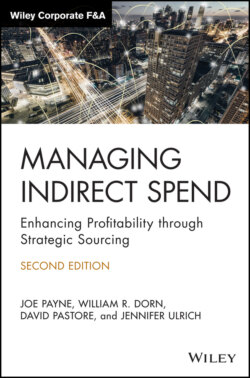Читать книгу Managing Indirect Spend - Joseph Payne, Joe Payne - Страница 42
SUPPLIER INTERVIEWS
ОглавлениеThe rationale for interviewing incumbent suppliers is the same as that for interviewing end users. The purpose is to get a contextual understanding of the category beyond the data derived from spend analysis—learning the background or history of the relationship, finding out what the supplier provides in terms of service, determining critical aspects of the relationship, and understanding what contractual obligations exist. In some cases, you may find that this step serves as a mere validation of what you previously learned from the end users you interviewed. Often, though, suppliers provide insight into the relationship that end users are not aware of or may not have articulated properly. Sometimes, suppliers can shed light on market conditions, new processes and technologies, and additional products and services that could be advantageous to your organization.
Overall, the supplier interview should be viewed as a collaborative brainstorming session. You should not invite the supplier in only to formally request information about the relationship. Instead, use the meeting as a platform to find out the supplier's pain points and motivation. What can your organization do better to help the supplier? What does a perfect customer look like? What additional business would the supplier like that it does not currently have? As we discuss in Chapter 6, understanding supplier motivation and leverage points is a vital part of the sourcing and negotiation process. The supplier interview is the optimal time to get this information and start the process on the right foot.
As part of the agenda for the meeting, ask the supplier to bring sales reports that you can review, along with any relevant paperwork that you may not have, such as contracts or pricing agreements. In addition, you will find it useful to request that the supervisor of the primary sales representative attend the meeting, which helps you better get to know who to go to if you are not getting what you need from your representative. This also gives you a good indication of how your primary representative works within the company and how aware the supervisor is of your account. If the supervisor is well up to speed, your account is probably important to your supplier, and your primary rep is doing a good job communicating your needs within their organization.
As described earlier in this section, you will want to use this meeting to uncover more details about what the supplier does for your organization and, if possible, learn more about the marketplace. Consider asking questions like the following during the supplier interview:
How long have you been a supplier for our organization?
In terms of account size, is our organization a top‐5 customer, top‐10, or other?
How would you rate us as a customer?
What could we do better as a customer?
What issues (quality, service, delivery, payment, other) have you encountered while working with our company? How have issues been resolved?
What services do you provide our company that might not be in the contract or on an invoice?
How would you differentiate yourself from your competitors?
Why do your competitors win business that you do not?
What measures do you take to ensure the quality of your product or service?
What is the process by which quality problems are resolved and corrected?
Do you provide any indemnification or insurance for your customers to protect against risk of loss due to product failure?
What are your standard payment terms? What are the terms for our organization?
Does our company take advantage of discounted terms?
How do you receive payment (check, ACH, etc.)? Do you have a preference?
What market changes and innovations are on the horizon for your industry? How does your organization intend to address those changes?
What are your goals and expectations for our account?
Of course, depending on the market and the supplier relationship, other questions should be considered, including questions related to price changes, freight terms (if applicable), and services, but these questions are a good start.
After going through the interview questions, review the reports that the supplier brought to the meeting. Do they include line‐item detail? If not, make the line‐item usage detail request an action item to be completed once the meeting is over. As we discussed earlier in the chapter, follow up the request by providing the supplier with a template indicating the type and detail of data you need and provide a deadline for completion of the request.
The last agenda item for a supplier interview is to inform the supplier of the process in which you are about to engage. You should be open and honest about the initiative, what's driving it, and your objectives. Let the supplier know that this is a company‐wide initiative and they are not being singled out. Keep in mind that, at this point, you do not know much about the competitiveness of the supplier's current pricing—you may already have a very good deal. Let the representative know that that just because your company is looking to reduce costs, this does not mean that there will be a bid. Also, make sure to communicate that you recognize they need to make money in order to stay in business, so your goal is to get to a market‐competitive price point that helps with your cost reduction objectives and helps them retain the business. Finally, ensure the supplier understands that all the critical aspects of the relationship and the supplier's service offering will be considered as you engage in this process.
